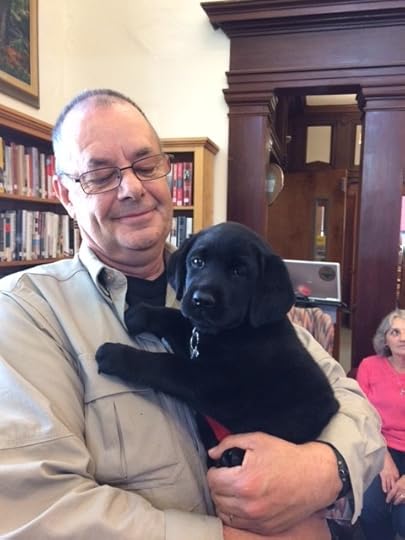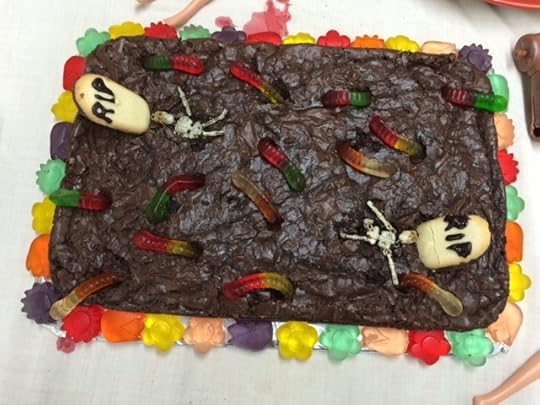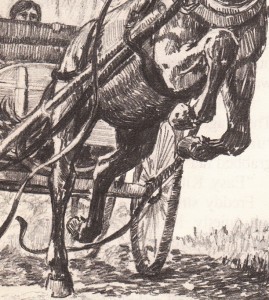Lea Wait's Blog, page 258
June 14, 2016
Murder at the Old Railway Chapel
Jen Blood here, to talk about an upcoming event I’m very excited about.
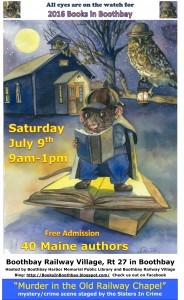 On the second Saturday of July for the past three years, I’ve been at Boothbay Railway Village for Books in Boothbay, an annual event sponsored by the Boothbay Public Library. Now in its twelfth year, Books in Boothbay features anywhere from forty to fifty-plus Maine authors housed under one roof, available to sign their books, chat with the public, and catch up with one another. Sherman’s Books and Stationery facilitates the whole shebang by providing the books, helping to organize the wayward authors, and ringing out customers. For the past three years, volunteer Sharon Pulkkinen has taken on the weighty task of contacting authors, organizing volunteers, making sure everyone’s information is current, and generally ensuring that Books in Boothbay continues to be a success. Not an easy feat, since organizing that many authors is very much like herding cats. Cats are more social, though.
On the second Saturday of July for the past three years, I’ve been at Boothbay Railway Village for Books in Boothbay, an annual event sponsored by the Boothbay Public Library. Now in its twelfth year, Books in Boothbay features anywhere from forty to fifty-plus Maine authors housed under one roof, available to sign their books, chat with the public, and catch up with one another. Sherman’s Books and Stationery facilitates the whole shebang by providing the books, helping to organize the wayward authors, and ringing out customers. For the past three years, volunteer Sharon Pulkkinen has taken on the weighty task of contacting authors, organizing volunteers, making sure everyone’s information is current, and generally ensuring that Books in Boothbay continues to be a success. Not an easy feat, since organizing that many authors is very much like herding cats. Cats are more social, though.
This year, I’m very pleased to say that I’ve coordinated a partnership between Sisters in Crime New England and Books in Boothbay for the first time. For those unaware, Sisters in Crime is an international organization devoted to the professional development and advancement of women crime writers. They host events, provide instruction and networking opportunities, and are generally just a great organization to have in the world. This year, in partnership with Books in Boothbay, Sisters in Crime New England will have a table at the event. We will not just have a table, though… We will have a mystery to solve. The Murder at the Old Railway Chapel will take place across from the Railway Village’s town hall, and will include a staged crime scene, suspects to interview, and a couple of great prizes for lucky winners who successfully solve the crime.
It’s been a lot of fun putting together the details of the mystery for the event, and has definitely stretched my sleuthing muscles in some exciting new ways. The unfortunate victim is a (fictional) fellow author, one Eunice K. Stoneheart, author of a series of cozies featuring a talking donkey. In my premise, Eunice is found the night before Books in Boothbay is to begin, lying prone beside a bloodied copy of Kate Flora’s Death Dealer. Murder most foul indeed. Eunice, naturally, was not without her enemies. She had announced recently that she intended to sell her books only in digital format going forward in order to save trees, and it had just been learned that she planned to stage a protest on the day of the Books in Boothbay event. Knowing Eunice’s predilection for spectacle and her litigious nature, those hosting the event were not pleased.
Additionally, Eunice was lobbying to have the narrator of her series — her own pet donkey, Louise — admitted as a member of Sisters in Crime. While this might have been laughable, Eunice had already secured a lawyer fully invested in moving forward with a lawsuit that would no doubt prove troublesome for the organization, if they did not comply. She had engaged fellow cozy writer (and Sisters in Crime New England Vice President) Edith Maxwell in a war of words over an incident Maxwell insisted had never happened (“I never touched her damn donkey, and I never would — what possible reason could there be for kicking a donkey? If it kicked me back, I’d be out of commission for months.”) Eunice had charged author Dale T Phillips with food poisoning, and had just announced a lawsuit against Maine Crime Writers’ own Kate Flora, charging her with reckless endangerment after Kate unwittingly brushed against the elderly Stoneheart with her grocery cart at the local Hannaford.
Clearly, many had motive.
If you’d like to try your hand at solving the crime, we’d love to see you. This year, Books in Boothbay will take place on Saturday, July 9, from 9 a.m. to 1 p.m. at the Boothbay Railway Village. Authors — including many here at Maine Crime Writers — will be onsite to sign books, and the Railway Village truly is a beautiful place to spend a summer day. I hope we’ll see you there!
Jen Blood is author of the bestselling Erin Solomon Mysteries, as well as the soon-to-be-released 5-Day Fiction Guide to Creating Complex Characters. To learn more, visit www.jenblood.com.
Murder at the Old Railway Village
Jen Blood here, to talk about an upcoming event I’m very excited about.
 On the second Saturday of July for the past three years, I’ve been at Boothbay Railway Village for Books in Boothbay, an annual event sponsored by the Boothbay Public Library. Now in its twelfth year, Books in Boothbay features anywhere from forty to fifty-plus Maine authors housed under one roof, available to sign their books, chat with the public, and catch up with one another. Sherman’s Books and Stationery facilitates the whole shebang by providing the books, helping to organize the wayward authors, and ringing out customers. For the past three years, volunteer Sharon Pulkkinen has taken on the weighty task of contacting authors, organizing volunteers, making sure everyone’s information is current, and generally ensuring that Books in Boothbay continues to be a success. Not an easy feat, since organizing that many authors is very much like herding cats. Cats are more social, though.
On the second Saturday of July for the past three years, I’ve been at Boothbay Railway Village for Books in Boothbay, an annual event sponsored by the Boothbay Public Library. Now in its twelfth year, Books in Boothbay features anywhere from forty to fifty-plus Maine authors housed under one roof, available to sign their books, chat with the public, and catch up with one another. Sherman’s Books and Stationery facilitates the whole shebang by providing the books, helping to organize the wayward authors, and ringing out customers. For the past three years, volunteer Sharon Pulkkinen has taken on the weighty task of contacting authors, organizing volunteers, making sure everyone’s information is current, and generally ensuring that Books in Boothbay continues to be a success. Not an easy feat, since organizing that many authors is very much like herding cats. Cats are more social, though.
This year, I’m very pleased to say that I’ve coordinated a partnership between Sisters in Crime New England and Books in Boothbay for the first time. For those unaware, Sisters in Crime is an international organization devoted to the professional development and advancement of women crime writers. They host events, provide instruction and networking opportunities, and are generally just a great organization to have in the world. This year, in partnership with Books in Boothbay, Sisters in Crime New England will have a table at the event. We will not just have a table, though… We will have a mystery to solve. The Murder at the Old Railway Chapel will take place across from the Railway Village’s town hall, and will include a staged crime scene, suspects to interview, and a couple of great prizes for lucky winners who successfully solve the crime.
It’s been a lot of fun putting together the details of the mystery for the event, and has definitely stretched my sleuthing muscles in some exciting new ways. The unfortunate victim is a (fictional) fellow author, one Eunice K. Stoneheart, author of a series of cozies featuring a talking donkey. In my premise, Eunice is found the night before Books in Boothbay is to begin, lying prone beside a bloodied copy of Kate Flora’s Death Dealer. Murder most foul indeed. Eunice, naturally, was not without her enemies. She had announced recently that she intended to sell her books only in digital format going forward in order to save trees, and it had just been learned that she planned to stage a protest on the day of the Books in Boothbay event. Knowing Eunice’s predilection for spectacle and her litigious nature, those hosting the event were not pleased.
Additionally, Eunice was lobbying to have the narrator of her series — her own pet donkey, Louise — admitted as a member of Sisters in Crime. While this might have been laughable, Eunice had already secured a lawyer fully invested in moving forward with a lawsuit that would no doubt prove troublesome for the organization, if they did not comply. She had engaged fellow cozy writer (and Sisters in Crime New England Vice President) Edith Maxwell in a war of words over an incident Maxwell insisted had never happened (“I never touched her damn donkey, and I never would — what possible reason could there be for kicking a donkey? If it kicked me back, I’d be out of commission for months.”) Eunice had charged author Dale T Phillips with food poisoning, and had just announced a lawsuit against Maine Crime Writers’ own Kate Flora, charging her with reckless endangerment after Kate unwittingly brushed against the elderly Stoneheart with her grocery cart at the local Hannaford.
Clearly, many had motive.
If you’d like to try your hand at solving the crime, we’d love to see you. This year, Books in Boothbay will take place on Saturday, July 9, from 9 a.m. to 1 p.m. at the Boothbay Railway Village. Authors — including many here at Maine Crime Writers — will be onsite to sign books, and the Railway Village truly is a beautiful place to spend a summer day. I hope we’ll see you there!
Jen Blood is author of the bestselling Erin Solomon Mysteries, as well as the soon-to-be-released 5-Day Fiction Guide to Creating Complex Characters. To learn more, visit www.jenblood.com.
June 13, 2016
A Question (and a Contest!)
Look, people. Let’s not beat around the bush. This September, I’ve got a new book coming out. It’s called RED RIGHT HAND, and it’s the followup to my Anthony, Barry, Lefty, and Macavity-nominated Michael Hendricks novel, THE KILLING KIND. I’m crazy psyched for folks to read it. So psyched, in fact, I’ve decided to give a signed ARC* away to one lucky MCW reader. How, you ask? Keep reading.

Hot off the presses.
*For those who don’t know, an ARC (or advance reading copy) is the early, uncorrected version of a book sent to reviewers well before the book’s release. RED RIGHT HAND’s ARCs were printed prior to copyediting, and differ slightly from the hardcover. That means a) they’re something of a collector’s item, and b) whoever wins one will get to read the version of the book I submitted to my editor, as well as mock my typos and questionable comma placements.
For those who don’t know, my wife, Katrina, is involved in the mystery community too, as a reviewer for Publishers Weekly, Mystery Scene, and Crimespree. She and I are fond of taking long walks, during which our conversations often turn to books.
The other day, our conversation centered on a question (which [hint, hint] might just come into play if you wanna win that ARC):
What book would you give to somebody who’s never read crime fiction to show them why you love the genre and what it’s capable of?
It’s an interesting question to me, because the answer isn’t necessarily your favorite book, it’s the book you think would be the best ambassador for the genre. (Some of my favorites [Donald Westlake’s Parker books, for example] are maybe too far down the genre rabbit hole to appeal to someone who’s never read a crime novel before.) And tastes vary so widely from recipient to recipient that it’s hard to choose one book with broad enough appeal.
Katrina offered two: Agatha Christie’s AND THEN THERE WERE NONE and Donna Tartt’s THE SECRET HISTORY. The former was the first adult mystery she ever read, and it ignited a passion for the genre that continues to this day. The latter (which, for the record, was in the running for me, too) is a beautifully written tale that puts the lie to the idea that crime fiction is lowbrow fare.
I’m similarly torn. I’m tempted to suggest Sir Arthur Conan Doyle’s THE HOUND OF THE BASKERVILLES because, like Katrina with Christie, I fell in love with it as a child. Or Raymond Chandler’s THE BIG SLEEP, which is as gorgeous on the sentence level as any book you’ll ever read. But instead, I’ll take the opportunity to choose a novel from one of my favorite current crime authors: Megan Abbott’s THE END OF EVERYTHING.
THE END OF EVERYTHING is at once a gorgeous literary novel, a heart-wrenching coming-of-age story, an unflinching work of crime fiction, and an expertly constructed fair-play mystery. It’s not an easy read by any means, but for me, it’s without a doubt one of the most satisfying in recent memory.
So… what book would you choose? Leave your answer in the comments, and be sure to include your name. Tomorrow (Wednesday) morning at 9AM EST, I’ll randomly select one commenter to receive the ARC (either by placing names in a hat or sorting via Excel’s random number generator, depending on my level of laziness), and notify the winner via the comments shortly thereafter. You’re welcome to leave multiple comments, but I’ll only count them as one entry.
June 12, 2016
Introducing a new environmental mystery
(Maine Crime Writers love to introduce our readers to new authors–mostly Maine authors–and books we think our readers will enjoy. Today’s guest is Charlene D’Avanzo, talking about her new eco-mystery)
 Charlene D’Avanzo: Last month I traveled to one of the most biologically diverse places in the world—Costa Rica. There were sloths, howling monkeys, alligator-like reptiles called caimans, birds galore. My buddies were super excited about an extra long, extra high zip line through the tropical forest, but I was not.
Charlene D’Avanzo: Last month I traveled to one of the most biologically diverse places in the world—Costa Rica. There were sloths, howling monkeys, alligator-like reptiles called caimans, birds galore. My buddies were super excited about an extra long, extra high zip line through the tropical forest, but I was not.
That’s because I’m terribly afraid of heights.
Despite my anxiety, I took a deep breath, clipped myself to a half dozen lines, and sped through the forest two hundred feet above terra firm. My journey to becoming a fiction writer has been kind of like that.
I call my books environmental mysteries because each has an environmental underpinning, and I think of the natural world (e.g., Maine’s coast) as a character in itself. Five years ago, another researcher’s horrific experience with climate change deniers triggered my decision to transform myself into a mystery writer. It seemed to me that scientists had failed to engage the public in this global emergency. Perhaps readers would be open to this message in a compelling story with engaging characters who happened to be scientists.
Like the zipline, it’s been an amazing ride—sometimes so scary and frustrating I screamed like a banshee, but always absorbing. I’ve held on and the first in my “Maine Oceanography” series will be published by a conservation press in June.
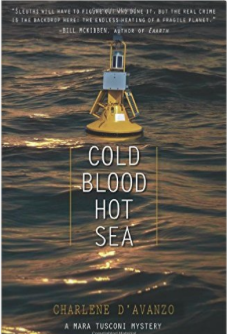 COLD BLOOD, HOT SEA is an amateur sleuth. Oceanographer Mara Tusconi tries to figure out who offed a dear colleague on a research cruise and why. The quest entangles Mara in a scheme headed up by powerful energy executives with much to lose by what Mara and other scientists at the Maine Oceanographic Institute are finding out. Mara and her sidekick and fellow scientist Harvey (Harville), face numerous trials, of course, including a sea kayak-motorboat chase in Maine’s icy waters at night. Mara’s flaws include one fatal for an oceanographer— she gets seasick.
COLD BLOOD, HOT SEA is an amateur sleuth. Oceanographer Mara Tusconi tries to figure out who offed a dear colleague on a research cruise and why. The quest entangles Mara in a scheme headed up by powerful energy executives with much to lose by what Mara and other scientists at the Maine Oceanographic Institute are finding out. Mara and her sidekick and fellow scientist Harvey (Harville), face numerous trials, of course, including a sea kayak-motorboat chase in Maine’s icy waters at night. Mara’s flaws include one fatal for an oceanographer— she gets seasick.
In adddition, the book is a cli-lit, eco-lit novel. Climate fiction is hot these days, but most novels are dystopian stories set in a devastated future. In contrast, COLD BLOOD, HOT SEA is contemporary, environmentally accurate with a positive message, and funny.
Charlene D’Avanzo is a marine ecologist, emeritus professor at Hampshire College, and award winning environmental educator. In 2015 she was awarded Mystery Writers of America’s McCloy scholarship for new writers. Her short stories are published in several anthologies including the eco-fiction collection “Winds of Change”. She’s a moderator on the Ecology in Literature and Arts site. Charlene lives on Little John Island in Yarmouth, Maine.
charlenedavanzo.com
author@charlenedavanzo.com
June 10, 2016
Weekend Update: June 11-12, 2016
 Next week at Maine Crime Writers there will be posts by Guest Author Charlene D’Avanzo (Monday), Chris Holm (Tuesday), Jen Blood (Wednesday), Barb Ross (Thursday), and Maureen Milliken (Friday).
Next week at Maine Crime Writers there will be posts by Guest Author Charlene D’Avanzo (Monday), Chris Holm (Tuesday), Jen Blood (Wednesday), Barb Ross (Thursday), and Maureen Milliken (Friday).
In the news department, here’s what’s happening with some of us who blog regularly at Maine Crime Writers: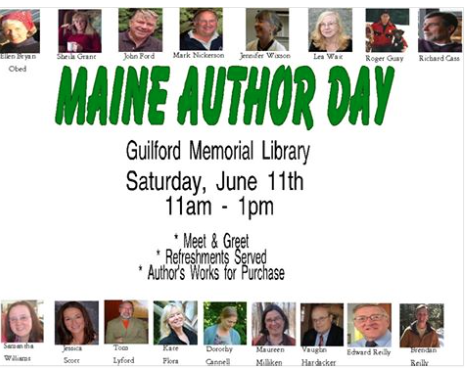
Yes — tomorrow, Saturday, June 11, you’ll find Maine Crime Writers Maureen Milliken, Kate Flora, Lea Wait, Richard Cass, and other wonderful Maine authors at the Guilford Memorial Library in Guilford, Maine. (That’s next to Hermon, near Bangor.) We’re looking forward to seeing each other — and YOU!
Looking ahead to the week of the 20th (because it is important to make plans!), Brenda Buchanan will be Downeast talking about her Joe Gale mysteries, particularly Cover Story, which is set in Washington and Hancock counties. On Thursday, June 23 at 6:30 p.m. she will be at the Swan’s Island Library and on Friday, June 24 at 4:30 p.m. she will be reading at the Winter Harbor Public Library.
On Thursday, June 23rd, Kate Flora and warden Roger Guay will be at the Jesup Library in Bar Harbor, talking about A Good Man with a Dog. Here’s a photo of said “good man” with an adorable eight-week-old lab puppy named Lucy at the Bridgeton Library last Tuesday. Maybe Lucy will come to Bar Harbor with us as well?
An invitation to readers of this blog: Do you have news relating to Maine, Crime, or Writing? We’d love to hear from you. Just comment below to share.
And a reminder: If your library, school, or organization is looking for a speaker, we are often available to talk about the writing process, research, where we get our ideas, and other mysteries of the business. And we encourage fun events like Death and Desserts, like the one last summer at the Liberty Library shown in the photos below.
Contact Kate Flora: mailto: kateflora@gmail.com
June 9, 2016
HANDS UP! GIMME ALL YOUR…
Not a holdup, but hands up and shoulders back and keep moving!
Because of years of back problems (and now osteoporosis and arthritis) and years of sitting at a keyboard, I’ve collected exercises and advice from various sources. Today I’m sharing some that can benefit writers, office workers, and others who sit long hours at desks and/or keyboards can benefit from exercises and activities aimed at preventing carpal tunnel, neck and back and hip pain, and weight gain.
PREVENTING CARPAL TUNNEL
Be sure you have your chair and keyboard so your wrists are straight rather than at an angle with the keyboard. Sit up straight like your mother told you. Don’t slump. Habitually letting shoulders slump forward can lead to “dowager’s hump” and rotator-cuff injury. A lumbar support cushion strapped to the chair back can facilitate this. The cushion’s pressure on the lower back is a great reminder to sit erect.
Train yourself to use the mouse with either hand, so you don’t overuse one hand. Even before I learned this about carpal tunnel, I taught myself to do this because of pain in my index finger from clicking and scrolling. I think the same thing could be true of using the touch pad repeatedly with the dominant hand.
This next sequence of exercises continues carpal tunnel prevention and helps keep arms and shoulders limber. Do these once and hour while you’re at the keyboard.
PRAY
Put your hands in a prayer position, pushing toward your sternum and with your elbows raised to the sides. Hold for a count of ten. Release the prayer hand position and point your fingers downward stiffly, pressing the backs of your hands together. Hold for a count of ten. Repeat that sequence three times.
Similarly, as in the photo, grasp the fingers of one hand with the other and pull back, hold for a count of ten and relax. Repeat the sequence three times with each hand.
SHAKE IT UP, BABY
Release and shake out your arms and hands. Hold your arms out straight from your sides and roll your arms and shoulders frontward, then backward.
STRENGTHENING
Remind yourself to stand straight with shoulders back as if the lumbar cushion is attached to your back, shoulder blades pinched together slightly. Get up at least once an hour and walk around, go up and down stairs, more often if possible. I set a small timer for twenty minutes.
SILLY WALK
A variation is to do gentle lunges, enough to tighten the buttocks but not enough to stress the knees. I do my silly walk down the long hall beside my basement office. When I began, to keep my balance, I touched the wall on both sides.
TURTLE
The head weighs about the same as a bowling ball, so as we age, we need strength to keep it vertical. This exercise will improve posture and strengthen neck muscles. Sit or stand straight, shoulders back, in the posture I described above. Looking forward, pull your head back, chin down, turtle-like. Hold for a count of five, then relax. Do five repetitions. Do the set three times a day. And here’s the “hands up” in my title.
This exercise will prevent the shortening of chest muscles and stretch your back. Sit or stand straight, shoulders down, shoulder blades slightly pinched together. Hold your arms out from your sides, elbows bent, hands pointed up so your arms form a big W, or wings. Pull your arms back and hold for a count of five, then relax. Do five repetitions. Do the entire set three times a day.
I’ve worked the Wings and the Turtle exercise into walks with my dog. Sasha doesn’t notice my nutty behavior, and neither do the birds and squirrels along our dirt road. None of these should be too time consuming and should improve flexibility and decrease risk of pain from overuse.
Lastly, pay attention to the body’s reactions, the movements and stretching of various muscles, and on your breathing. Focusing on the present moment and on the sensations created by the various exercises can reduce stress and increase the benefit of the activity.
I invite commenters to suggest additional activities or exercises to add to the repertoire.
June 8, 2016
Baseball is Life; Life is Baseball
By Brenda Buchanan
Baseball is reassuring.
It makes me feel as if the world is not going to blow up.
Pulitzer prize-winning poet Sharon Olds said that, and she’s right. Especially in this crazy political summer that we all know is going to get waaaaay crazier, it’s gives me deep comfort to turn on NESN and watch my Red Sox at the end of a long day.
It helps that they’re winning, with Big Papi hitting the cover off the ball in his final season and a cluster of bright young stars who not long ago ran the bases and swung for the fences at Hadlock Field in Portland. But win or lose, the Sox are my team, and have been since they almost won the World Series in 1967, when I was eight years old.
Last Sunday we made our first foray of the year to Fenway Park . It was a gray-sky day, a sharp contrast to my usual Red Sox weather karma, but we were under the grandstand behind first base, so the occasional showers didn’t matter a whit.

The view from our seats, June 5
As you can see, a post blocked my view of home plate, obstructed view seats being the price we pay to watch our team play in a one-of-a-kind of a ballpark built more than a century ago. But I did have a perfect view of the pitcher, who, with the exception of Big Papi, usually is the most entertaining player on the field.
In his essay collection Five Seasons: A Baseball Companion, the great Roger Angell illustrated this truth with this sublime description of Red Sox Hall of Famer Luis Tiant, who also attended Sunday’s game:

El Tiante, in his heyday
Tiant, noted for odd pitching mannerisms, is also a famous mound dawdler. Stands on hill like sunstruck archeologist at Knossos. Regards ruins. Studies sun. Studies landscape. Looks at artifact in hand. Wonders: Keep this potsherd or throw it away? Does Smithsonian want it? Hmm. Prepares to throw it away. Pauses. Sudd. discovers writing on object. Hmm. Possible Linear B inscript.? Sighs. Decides. Throws. Wipes face. Repeats whole thing. Innings & hours creep by. Spectators clap, yawn, droop, expire.
These days a clock is supposed to keep pitchers from such antics, but the game still unfolds at a leisurely pace. Sunday’s game featured the anomaly of every hit by both teams from the first inning through the eighth being a home run, every single one of them over the Green Monster.
How often does that happen?
Going into the bottom of the ninth the Sox were down 5-1. Then Hit! Hit! Hit! Hit! All of a sudden it was 5-4 and there were two guys on base and two out and (sigh) a rookie pinch hitter struck out. Final score 5-4, Toronto.
What does my devotion to the Red Sox have to do with crime writing? Did you not just read my account of the game? It was a tutorial in suspense and a primer on human emotion. As the late Joe Garagiola, former player and play-by-play announcer, once said:
[The game of baseball is] drama with an endless run and an ever-changing cast.
Former baseball commissioner and one-time president of Yale University Bart Giamatti, who knows his way around literature of the English Renaissance, made a similar observation:
B aseball is the most nourishing game outside of literature. They both are re-tellings of human experience.

The front pages from the Boston Globe for the three World Series championship wins in 2004 (such a rush) 2007 (we did it again!) and 2013 (really?)
For those of you who may not be baseball fans, consider the words of fellow crime writer Harlan Coben. Instead of comparing baseball to writing, he compared writing to baseball:
I like to see the difference between good and evil as kind of like the foul line at a baseball game. It’s very thin, it’s made of something very flimsy like lime, and if you cross it, it really starts to blur where fair becomes foul and foul becomes fair.
Isn’t that what we do every day? Place some of our characters on the right side of the line, others on the left, and the most intriguing of them with one foot on either side?
I started this post with a poet’s words so I’ll end it with this trenchant observation by former Maine poet laureate Baron Wormser who said of the greatest game:
It’s the keenness of conflict that appeals.
True of baseball. True of crime writing.
A Serious, But Seldom Discussed Maine Issue
John Clark discussing an important, but seldom talked about issue in Maine. At a time when the population is getting older, our state department of transportation has shut down at least four rest areas on I-95. The two just north of Augusta and the two just south of Pittsfield are no more. Good thing there’s no truth to the two Maine theory because all four are north of what I consider to be the imaginary line dividing those two Maines that don’t exist.
Granted, as a guy, I can pull over in any rural area when the call of nature strikes (something that happens more when you get to be my age, alas), but that’s not particularly true on the turnpike or I-95. In fact the last time I did so, A state cop pulled up and quizzed me about my intentions. Heck, even the Airline has more pit stops than the interstate now. As for women, the stop and relieve option isn’t one often considered.
This brings me to an idea that’s been floating around in my head for a while. In an era where corporations are eager to purchase naming rights to arenas and stadiums, why not sponsored rest areas. It’s been done in Arizona, Florida, Iowa and Virginia in various ways already. I’m here to promote the concept and suggest a few potential candidates. I welcome your added sponsors and slogans in the comments section.
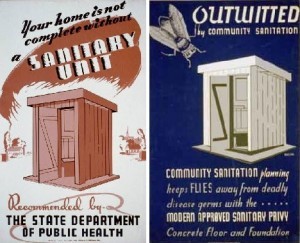
From a time when government cared
Depends is a natural with the “We’ve got you covered, no matter where you’ve gotta go,” welcome sign. Tim Horton’s would be another (providing Dunkin Donuts or Starbucks don’t scoop them) with dual offer of relief and a discounted recharge to keep folks going until they can’t. Then there’s Maxwell House, proclaiming their rest area is “Good to the Last Drop.”
Nike would be perfect with their “Just Do It” campaign, while even Hallmark might have an interest in sponsorship with their ‘When You Care Enough to Send the Very Best.”
I suspect there might even be a sponsorship battle between the ED moguls given the slogans “It Ain’t Gonna Fix Itself,” and “Freedom to be Ready and Relaxed.” Other drug companies are definitely in the running. Consider Alka-Seltzer’s timeless slogan “Plop, plop, fizz, fizz, oh what a relief it is,” or Rolaids “How Do You Spell Relief?”

Who wouldn’t want to sponsor something like this?
Soft drink giant Coke is another possibility with “The Pause That Refreshes,” then there’s Mastercard. Imagine a rest area proclaiming “There are some things money can’t buy. For everything else, there’s MasterCard.”
Even the political parties are liable to get in on the action, depending upon which one comes up with the best take on the trickle-down, not to mention the possibility of Microsoft getting in on the act by grabbing all rest area sponsorship sites, thus answering the question posed in their ad slogan “Where do you want to go today?”

Imagine something like this on the horizon when ya gotta go (this is a real rest area from Europe)
How about the tourism industry, starting with Holiday Inn. Imagine pulling in when you’re at the end of your rope to be greeted by a sign saying “Pleasing People the World Over.” Even major cities can get in on the act, beginning with Las Vegas and “What Happens Here Stays Here.”
Last but not least is Home Depot with their greeting at the rest stop south of Lincoln “You Can Do It, We Can Help.”
I bet some enterprising and creative readers can come up with even better corporate sponsors. Feel free to share them in your comments.
June 6, 2016
The Waldoboro Public Library
Dorothy Cannell: Some years ago I was talking with a friend who had moved to the U.S. from England as an adult, as I had done. Our conversation revolved around the strong pull that the country of our birth and upbringing still had upon us both.
“But how much is nostalgia?” She mused. “Our England was rooted in the forties and fifties. That world is gone; but we’re left wanting the village – the thatched cottage next door to Miss Marple.”
In my case there had never been the village or cottage thatched or otherwise; the reality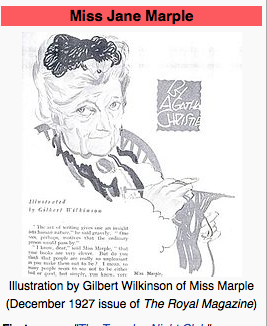 had been an ordinary town with nothing picture post card about it, but there had been Miss Marple met during my early forays in reading mysteries. For me one of the wonders of fiction is that it took me from an early age to places that I could weave into my reality in the sense of their becoming part of who I am. The vast majority of the books I read during my childhood came from the library where I went almost every Saturday afternoon with my father. Those memories instilled a lifelong love of libraries. For the availability they provide of catching a magic carpet ride to a thousands of destinations I might otherwise never visit, I am deeply grateful.
had been an ordinary town with nothing picture post card about it, but there had been Miss Marple met during my early forays in reading mysteries. For me one of the wonders of fiction is that it took me from an early age to places that I could weave into my reality in the sense of their becoming part of who I am. The vast majority of the books I read during my childhood came from the library where I went almost every Saturday afternoon with my father. Those memories instilled a lifelong love of libraries. For the availability they provide of catching a magic carpet ride to a thousands of destinations I might otherwise never visit, I am deeply grateful.
When my husband Julian and I moved to Maine in 2004, I had a sense of coming home. In England whether in town or village, one is never far from the sea and much as I had enjoyed living in the mid-west I had felt landlocked. Here I additionally felt restored to a simpler time, before life became so fiercely busy that the days get eaten up without the opportunity to savor their aroma let alone taste them. A place where community still matters, sustaining and enriching within the wide range of happenings between festivals or funerals.
These thoughts are in the forefront of my mind because last Saturday I participated in an open house celebrating the centennial of The Waldoboro Public Library. I had not been to Waldoboro previously, but once turning from Route 1 onto Main Street there was again that tug of familiarity, the recognition of Maine’s small town variation of an English village. A location where people’s lives intertwine with those of their neighbors, their past and their present.
I arrived a little early because afraid of getting lost enroute. Other authors (including Lea Wait) and local celebrities were present. There was a loaded table of wonderfully good things to eat supplied by volunteers, but it was the warmth and cheerful excitement of celebrating a majorly important anniversary of Waldoboro’s history that encouraged me to ask if there was a booklet regarding the establishment of the library and it’s growth that I could take
 Here are some excerpts from The Waldoboro Public Library 1916 to 1983.
Here are some excerpts from The Waldoboro Public Library 1916 to 1983.
‘In 1916, a group of Waldoboro residents met formally and set up the procedure for answering what they saw to be Waldoboro’s need for a public library.
‘In the beginning, the books that were to form the core of the collection were gathered from personal libraries, donated by local institutions, purchased with money given by local groups and individuals, thus forming a truly representative collection of books, which people enjoyed, considered useful, or wished to consult. It is a concept that once pervaded all libraries and that is seen most clearly in small libraries in which every dollar spent on books must be turned twice in order to get the community’s money’s worth.’
‘As with most libraries, the policies and the patrons adjusted to each other by degrees – hours changed and changed again, emphasis went back and forth between educational and recreational usage. Policies, which were to continue into tradition, began and grew. The use of a pay shelf (with a charge of two cents a day in 1918) for the latest best sellers, the two-librarian system in 1967 on the retirement of the redoubtable Sarah Lash who had been the librarian for 37 years, the volunteer nature of much of the work of running the library.’
Here’s my favorite:
‘The Waldoboro Library it was and the Waldoboro Library it would remain – heavily used, often overcrowded, wistfully dreaming of bigger things.’
I like that – Change walking arming in arm with the Past into the Future.
Happy reading,
Dorothy
June 5, 2016
The Story Behind A Story
Kaitlyn Dunnett/Kathy Lynn Emerson here, once again writing about my grandfather, Fred Gorton of Liberty, New York, last seen in “The First RFD Carrier in Town” This post also has to do with me and my writing.
Grampa wrote his memoirs when he was in his eighties. I used some of the stories he told about growing up in the 1880s early in my career when I wrote a children’s book for ages 8-12, Julia’s Mending, but it was a story of his from 1910 that ended up inspiring one of the first pieces of short fiction I ever had published.
There are two versions of events, the one in the newspaper at the time and Grampa’s account written years later. Here’s what the newspaper reported:
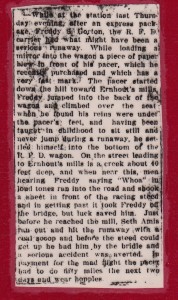 While at the station last Thursday evening, after an express package, Freddy S. Gorton, the R. F. D. carrier, had what might have been a serious runaway. While loading a mirror into the wagon a piece of paper blew in front of his pacer, which he recently purchased, and which has a very fast mark. The pacer started down the hill toward Ernhout’s mills. Freddy jumped into the back of the wagon and climbed over the seat. When he found his reins were under the pacer’s feet, having been taught in childhood to sit still and never jump during a runaway, he settled himself into the bottom of the R.F.D. wagon. On the street leading to Ernhout’s mills is a creek about 40 feet deep. When near this, men hearing Freddy saying ‘Whoa’ in loud tones, ran into the road and shook a sheet in front of the racing steed. Getting past, it took Freddy on the bridge but luck saved him. Just before he got to the mill, Seth Amis ran out and hit the runaway with a coal scoop and before the steed could get up he had him by the bridle and a serious accident was averted. In payment for the mad flight the pacer had to do 50 miles the next two days and wear hopples.
While at the station last Thursday evening, after an express package, Freddy S. Gorton, the R. F. D. carrier, had what might have been a serious runaway. While loading a mirror into the wagon a piece of paper blew in front of his pacer, which he recently purchased, and which has a very fast mark. The pacer started down the hill toward Ernhout’s mills. Freddy jumped into the back of the wagon and climbed over the seat. When he found his reins were under the pacer’s feet, having been taught in childhood to sit still and never jump during a runaway, he settled himself into the bottom of the R.F.D. wagon. On the street leading to Ernhout’s mills is a creek about 40 feet deep. When near this, men hearing Freddy saying ‘Whoa’ in loud tones, ran into the road and shook a sheet in front of the racing steed. Getting past, it took Freddy on the bridge but luck saved him. Just before he got to the mill, Seth Amis ran out and hit the runaway with a coal scoop and before the steed could get up he had him by the bridle and a serious accident was averted. In payment for the mad flight the pacer had to do 50 miles the next two days and wear hopples.
After reading this account, I had to do a bit of research. For one thing, what the heck are hopples? Turns out they’re hobbles and you hobbled a horse so it could only take tiny steps. As a punishment today, that would be considered cruelty to animals.
When he came to write his memoirs (online as The Life of a Plodder), Grampa remembered the incident a bit differently. Here’s his version:
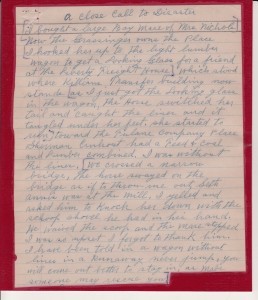 I bought a large bay mare of Mrs. Nichols. I hooked her up to the light lumber wagon to get a looking glass for a friend at the Liberty freight house. As I just got the looking glass in the wagon, the horse switched her tail and caught the lines and they tangled under her feet. She started to run. We crossed a narrow bridge. The horse swayed on the bridge as if to throw me out. Seth Amis was at the mill. I yelled and asked him to knock her down with the scoop shovel he had in his hand. He waved the scoop and the mare stopped. I was so upset I forgot to thank him. I have been told in a wagon without lines in a runaway never jump. You will come out better to stay in, as maybe someone may rescue you.
I bought a large bay mare of Mrs. Nichols. I hooked her up to the light lumber wagon to get a looking glass for a friend at the Liberty freight house. As I just got the looking glass in the wagon, the horse switched her tail and caught the lines and they tangled under her feet. She started to run. We crossed a narrow bridge. The horse swayed on the bridge as if to throw me out. Seth Amis was at the mill. I yelled and asked him to knock her down with the scoop shovel he had in his hand. He waved the scoop and the mare stopped. I was so upset I forgot to thank him. I have been told in a wagon without lines in a runaway never jump. You will come out better to stay in, as maybe someone may rescue you.
With two versions of the story and a little more research so I’d know more about freight houses and wagons and looking glasses, I created a third . . . with one very significant change at the end, and made it into a short story for children. It’s titled, unoriginally, “Runaway.”
Runaway
by
Kathy Lynn Emerson
Freddy spread a heavy blanket over the planks in the back of the light lumber wagon. As soon as it was in place, Father and Douglas loaded the looking glass aboard. They were all very careful. The looking glass was a present for Mother. It had been shipped all the way from New York City.
Freddy folded the blanket over their reflections in the mirror. Douglas tucked in the corners.
“There. All safe,” he said.
They each breathed a sigh of relief.
The freight house doors gaped wide in the October sunlight. Somewhere in the blackness was the freight master’s office.
“I’ll be right back,” Father said. “You two stay here.”
He disappeared inside the building.
Freddy sat down next to the looking glass and glanced around. There wasn’t much to see. The dusty street was empty of people, except for Douglas. Freddy thought that Kit, the horse, was more interesting. She was a big bay mare Father had just bought. She was fidgeting in the traces. She wasn’t used to the wagon yet.
“Easy, Kit,” Freddy whispered. “Calm down, now.”
Kit didn’t listen. Just as Freddy spoke, a piece of paper blew in front of her. The mare switched her tail once and was off. Before Freddy realized what had happened, they were speeding down the hill.
“Runaway!” Douglas yelled.
He made a dive for the tailboard . . . and missed! Freddy was the only one in the wagon as Kit raced away. Douglas was left behind, sprawled in the roadway and covered with dust.
It wasn’t easy to climb forward over the bouncing seat. Somehow Freddy managed it and looked for the reins. The ends should have been tied in place, but they were gone. For the first time, Freddy felt afraid. Kit’s tail had caught the lines. They were dragging along the ground, tangled and far out of reach. There was no way now to stop Kit’s mad flight.
Freddy tried to stay calm. Father had told them once that it was safer to stay put in a runaway than to try to jump out. The wagon swayed dangerously as Kit crossed the narrow bridge at the foot of the hill. Freddy’s eyes widened. The deep, cold water of Shaw’s Creek came very close. Father hadn’t said anything about being thrown out!
In a panic, Freddy scrambled back over the seat and crouched in the bottom of the wagon. The mirror was sliding back and forth across the planks. Freddy tried to steady it and hold on tight to the edge of the seat at the same time. It was tricky.
“Whoa!” Freddy hollered. “Whoa, Kit!”
Kit paid no attention.
By now there were more shouts of “Runaway!” Some men waved their arms at Kit as she raced by them, but they only frightened her more. She sped on toward Bonner’s Mill.
Freddy peered fearfully over the top of the seat and yelled “Whoa, Kit!” again. Ahead, Seth Ames came into sight. He was walking slowly out of the mill, carrying a coal scoop. He didn’t see them coming.
“Mr. Ames! Look out!” Freddy cried.
Seth turned around and saw Kit and the wagon bearing down on him. For a moment, he stood frozen in place. Then, too late, he tried to leap out of the way. The scoop shovel in his hand waved wildly and came down on Kit’s head.
Startled, the horse stumbled and almost fell. The wagon bounced to a halt. Before Kit could run again, Freddy had scrambled out and grabbed her bridle.
“Easy, Kit. Easy, girl.”
Freddy stroked the mare’s nose and kept talking quietly. Kit wasn’t hurt, but she was frightened. Her eyes rolled wildly. She’d just begun to calm down when Father and Douglas came into sight.
“Are you all right?” Father shouted as he ran.
“I’m fine. So’s Kit. And so’s the looking glass.” Miraculously, it hadn’t broken.
Father began to laugh with relief. By the time he reached the wagon, he was shaking his head in amazement. He often did that around Freddy.
“You’re a brave girl, Fredericka,” he said.
So that’s the story, and the story behind the story. After several rejections, “Runaway” was published in 1985 in an obscure children’s magazine distributed to Sunday Schools. I was paid, if I remember correctly, a whopping $7.50 for first rights. It was my second short fiction sale and only the fourth time I’d sold anything I’d written, and most of the credit goes to Grampa Gorton.
Kathy Lynn Emerson/Kaitlyn Dunnett is the author of over fifty books written under several names. She won the Agatha Award for best mystery nonfiction of 2008 for How to Write Killer Historical Mysteries and was an Agatha Award finalist in 2015 in the best mystery short story category for “The Blessing Witch.” Currently she writes the contemporary Liss MacCrimmon Mysteries (Kilt at the Highland Games ~ July 2016) as Kaitlyn and the historical Mistress Jaffrey Mysteries (Murder in the Merchant’s Hall) as Kathy. The latter series is a spin-off from her earlier “Face Down” series and is set in Elizabethan England. Her websites are www.KaitlynDunnett.com and www.KathyLynnEmerson.com
Lea Wait's Blog
- Lea Wait's profile
- 509 followers


